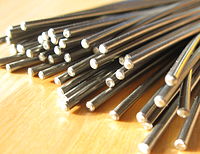
Photo from wikipedia
In recent decades, shape memory alloys (SMAs) have attracted attention because of their combined functional properties of actuating and sensing, associated with the shape memory effect (SME), and their superelasticity.… Click to show full abstract
In recent decades, shape memory alloys (SMAs) have attracted attention because of their combined functional properties of actuating and sensing, associated with the shape memory effect (SME), and their superelasticity. The unique SME and superelasticity realized in SMAs result from a thermoelastic martensitic transformation and its reverse transformation. The SME is a phenomenon in which a sample is deformed in a low-temperature phase (martensite) and subsequently regains its original shape upon heating above a certain temperature by the reverse martensitic transformation. Superelasticity, another important property of SMAs, occurs at a high-temperature range (in the parent phase). After the sample undergoes a nonlinear deformation, it can completely recover upon unloading because of the reverse stress-induced martensitic transformation. Among SMAs, TiNi-based SMAs are the most commercially successful materials because of their excellent functional properties (SME, superelasticity), corrosion resistance, and biocompatibility with the human body. As a result, various engineering and biomedical applications of TiNi alloys have been developed, such as couplings, actuators, orthodontic arches, stents, and bendable surgical tools. Very recently, TiNi-based SMAs have also been regarded as promising candidates for solid-state cooling applications because of the large elastocaloric effect originating from the stress-induced martensitic transformation. The adiabatic temperature change of TiNi-based SMAs can reach up to 10–30 C. From a practical application point of view, two key problems hinder the further applications of TiNi-based SMAs. One is functional fatigue and the other is the relatively low transformation temperature (TT). In recent years, some important progress has been achieved in TiNi-based SMAs to overcome these issues. In most cases, TiNi-based SMAs have to be exposed to thermal/stress cyclic conditions. Functional fatigue, also termed the cyclic instability of functional properties, which describes the degradation behavior of martensitic transformation, the SME, and superelasticity, inevitably occurs during these cyclic conditions. For TiNi alloys, the characteristic temperatures of martensitic transformation usually decrease with increasing thermal cycle number because of the introduction of dislocations, which compensate for the crystallographic compatibility between the martensite and parent phases. R-phase transformation and precipitation of the Ti3Ni4 phase are even induced by such thermal cycling. Deformation cycling also significantly influences superelastic behavior, as demonstrated by the change in the stress–strain curve. With increasing cycle number, the stress–strain curve of TiNi alloys is characterized by the following features: 1) reduced critical stress to induce martensitic transformation and stress hysteresis and 2) increased slope of the stress plateau and irreversible strain. These results indicate that the functional fatigue of TiNi alloys is unsatisfactory and hinders their use in applications requiring precise control or longduration operation, for example, elastocaloric cooling or artificial heart valves. To improve functional fatigue, long-term efforts have been made to tailor the microstructure or composition, Prof. Y. Tong, Dr. A. Shuitcev Institute of Materials Processing and Intelligent Manufacturing College of Materials Science and Chemical Engineering Harbin Engineering University Harbin 150001, China E-mail: [email protected] Prof. Y. Zheng Department of Materials Science and Engineering College of Engineering Peking University Beijing 100871, China E-mail: [email protected]
Journal Title: Advanced Engineering Materials
Year Published: 2020
Link to full text (if available)
Share on Social Media: Sign Up to like & get
recommendations!